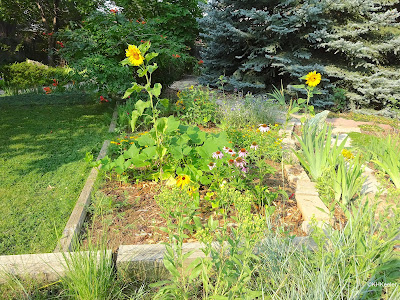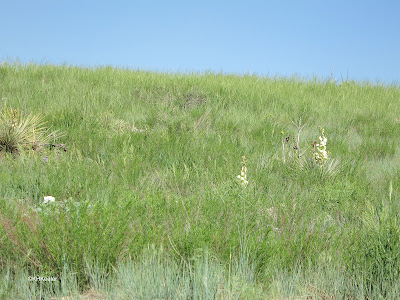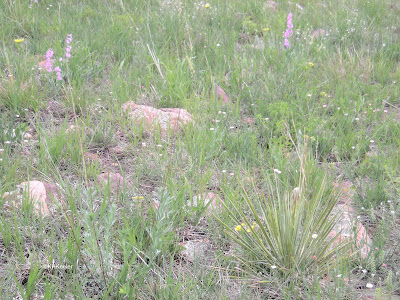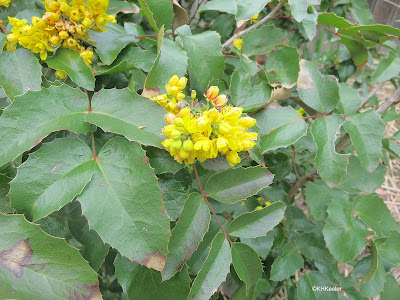I was easy to convince that native animals and the plants they depend on are declining, hit by the double whammy of land development and competition from introduced species. DougTallamy's solution--that we all grow some native plants in our yards and foster native animals by tolerating insect damage --birds eat insects! -- also made sense to me. (See more on the logic: link). Thus, I reviewed my yard and found a few natives, but many more garden plants introduced from Eurasia, as well as a nice collection of exotic weeds. So I resolved last winter not to add any plant that wasn't native (for a while at least) and replace plants that died with natives.
 |
| The photo has several natives but as many nonnatives |
Those were better as resolutions than as reality.
First, you have to know what is native and acquire it. I talked about how to know a native previously (link). I have a good idea what my property was like before settlement: a rocky grassland. I can see many of the plants in local natural areas. Buying them is something else; many common ones are not generally for sale. Others went quickly "Out of Stock," so I can't buy them this year. Still others came with complex germination instructions. I tried, but they didn't come up. (Maybe they still will). I'll solve all that eventually, but it is discouraging. For six great ideas, I have three plant species to add to my yard.
 |
| Rocky Mountain foothills grassland, likely what my native vegetation looked like |
Tallamy and others suggest that for the goal of supporting native animals like birds, some plants are better for hosting native insects than others. The absolute best appear to be oaks, genus Quercus. Tallamy and his students and colleagues found 534 different insect species used a single oak tree! Those results have been confirmed on oaks elsewhere. Other tree species were used by fewer insects. He recommended, to most quickly help native animals, plant an oak.
 |
| A small oak tree |
Excellent advice...for most places. However, Colorado has only three native oaks and none of them grow in my county, according to the Flora of Colorado. I can plant an oak, but it isn't going to have the impact it would in Syracuse or Sacramento, where all sorts of native insects will be delighted to discover it. No doubt some other plant fills the role of oak--food for dozens of insects--in my zip code, though it isn't obvious what. In fact, I live in the grasslands part of the Rocky Mountain foothills. There were no trees except in the canyons a bit higher or on the stream flood plains; any tree I plant is slightly exotic.
 |
| Another view of Rocky Mountain foothills grassland |
I don't want a yard without trees, so there are going to be some compromises.
Bringing in natives looks like it is going to be an ongoing set of compromises, actually. I have happily let trees that sprouted in my yard grow up to provide shade (junipers, maples, a pin oak, chokecherry). Now, it is hard to plant those natives I purchased, because they need full sun. I don't have much area that's in full sun any more. I don't even have a place for sunflowers; the spots along the fence--sunflowers get TALL--are all pretty shady. (I learned early in my gardening to pay attention to how big the plants get, tho that first photo above shows I'm a slow learner: sunflowers in the middle of a flower bed!)
 |
| Common sunflowers, Helianthus annuus get big and like full sun. My goldfinches love them. |
Your specific problems will be different, but you'll have them. Adapting a yard to support natives includes a lot of details and many are tricky.
When grand projects hit stumbling blocks, celebrate small successes. Here's one of mine: many different insects--honey bees, bumblebees, native bees, tiny bees I could barely see, beeflies--visited the flowers of creeping hollygrape (Berberis repens), one of my natives, and a plant whose flowers I had scarcely noticed before this year. Who knew it was a pollinator magnet?!
 |
| creeping hollygrape, Berberis repens No pollinators in the photo: I was too slow. |
Comments and corrections welcome.
References
Ackerfield., J. 2015. Flora of Colorado. BRIT Press, Fort Worth, Texas.
Tallamy, D.W. Homegrown National Park link (Accessed 5/20/22).
Tallamy, D. W. 2007. Bringing Nature Home. Timber Press. Portland, OR.
Tallamy, D.W. 2019. Nature's Best Hope. Timber Press. Portland, OR.
Kathy Keeler, A Wandering Botanist
More at awanderingbotanist.com
Join me on Facebook: https://www.facebook.com/AWanderingBotanist
I wonder if, and how many, native insects and birds are being replaced with “urban generalists”, due to the non-native canopy of trees and such along the Front Range. Since most or all of our native birds prefer open grassland, the city habitat seems to favor the shorter list of human-adapted species. Do you think that is accurate? And I wonder if the same applies to insect populations?
ReplyDeleteI don't know. I'm concerned about the forest/grassland issue and am trying to gather information. I hope that insects are so small that they find a suburban yard where their food plants are growing vigorously big enough to be good habitat. Grassland birds don't like shady urban areas. But maybe birds breeding in the open space that wanders through NoCo will forage into native plant gardens and benefit from the insects and fruits there. Increasingly, animals from foxes to titmice are adapting to live among humans. The challenge on the Front Range may be greater than in the forested East, but we also have lots of natural areas/ open space with much less disturbance from which insects can disperse if their habitat is recreated.
ReplyDelete